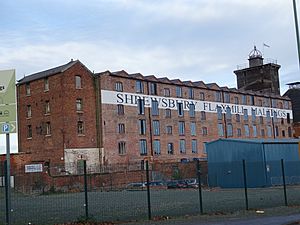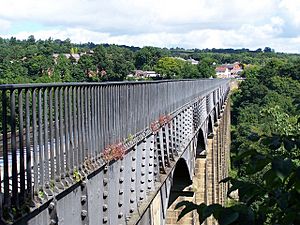William Hazledine facts for kids
Quick facts for kids
William Hazledine
|
|
|---|---|
| Born |
Shawbury, Shropshire, England
|
| Died |
Shrewsbury, Shropshire, England
|
| Occupation | Engineer |
| Spouse(s) | Miss Brayne |
| Engineering career | |
| Discipline | Ironmaster Structural engineer |
| Projects | Chirk Aqueduct Menai Bridge |
William Hazledine (1763 – 1840) was a very important English engineer. He was known as an "ironmaster" because he was an expert at working with iron. He built huge factories called foundries. There, he was one of the first to make strong iron parts for big structures. He helped build amazing things like bridges and aqueducts (water bridges for canals).
Many of his most famous projects were with another famous engineer, Thomas Telford. These include the amazing Pontcysyllte Aqueduct and the Menai Suspension Bridge. Thomas Telford even called him "Merlin Hazledine" because he was so good at his job, like a magician!
Contents
William Hazledine's Early Life and Work
William Hazledine was born in Shawbury, England, in 1763. His father was a millwright, someone who built and repaired mills. When William was young, his family moved to a place called Sowbatch.
William and his brother John learned how to be millwrights from their uncle. Later, his brothers started their own ironworks.
Starting His Own Business
Around 1780, William helped set up machines at Upton Forge near Shrewsbury. A forge is a place where metal is heated and shaped. Years later, he rented this forge. It became a key place for making wrought iron for his projects.
He moved to Shrewsbury and, around 1787, started a business with Robert Webster. Robert was a clockmaker and inventor. They opened a foundry in Cole Hall, near the Welsh Bridge in Shrewsbury. A foundry is a factory where metal is melted and poured into molds.
In 1789, William joined the Freemasons. There, he met Thomas Telford, who would become his famous partner. William's first known ironwork was in 1792. He made cast iron columns for St Chad's Church, Shrewsbury. These columns helped support the church's upper gallery.
William's partnership with Robert Webster ended. In 1793, he bought land in Coleham, Shrewsbury. He built a much bigger foundry there. This new factory used steam power and eventually employed almost 500 workers! In 1796, he made the iron frame for the Ditherington Flax Mill. This building was designed by Charles Bage. It was the first building in the world to have an iron frame.
Working with Thomas Telford on Big Projects
William Hazledine supplied iron parts for many of Thomas Telford's projects. These two engineers worked together on some truly amazing structures.
Building Aqueducts
He made the iron deck for the Chirk Aqueduct, which was finished in 1802. An aqueduct is like a bridge that carries water, often for canals.
He also built a large foundry at Plas Kynaston in Cefn Mawr. From there, he made the iron deck for the nearby Pontcysyllte Aqueduct. This incredible structure was completed in 1805.
Creating Iron Bridges
The Bonar Bridge in Scotland was a new kind of bridge designed by Telford. It had a long central section. It was built between 1811 and 1812. The iron parts were made at Hazledine's Plas Kynaston foundry. Hazledine even oversaw the building of the bridge.
They built several more bridges using this design. One was the Mythe Bridge at Tewkesbury, finished in 1826.
Canals and Suspension Bridges
From about 1815 to 1820, Hazledine provided and installed lock gates for the western part of Telford's Caledonian Canal. Lock gates are like big doors that help boats move up and down in canals.
In 1821, Hazledine agreed to supply all the iron for the Menai Suspension Bridge. This famous bridge, designed by Telford, was finished in 1826. He also supplied the iron for Telford's Conwy Suspension Bridge, completed in the same year. The strength of the iron chains, made at Upton Forge, was very important for these huge suspension bridges.
Later Years and Legacy
William Hazledine was the mayor of Shrewsbury from 1835 to 1836.
He passed away in 1840 at his home in Shrewsbury. He was buried at St Chad's Church, Shrewsbury. There is a memorial with a bust (a sculpture of his head and shoulders) of Hazledine in the church.
Famous Structures by Hazledine
Hazledine's work left behind many amazing structures, including:
- Ditherington Flax Mill, Shrewsbury (1797)
- Chirk Aqueduct, Froncysyllte (1799)
- Craigellachie Bridge, Scotland (1812–1814)
- Menai Suspension Bridge (1819–1826)
- Mythe Bridge, Tewkesbury (1823–1826)
- Aldford Iron Bridge, Eaton Hall, Cheshire (1824)
- Conwy Suspension Bridge (1824–1826)
- Cleveland Bridge, Bath (1826)
- Stretton Aqueduct, Staffordshire (1832–3)
Places Named After Him
In Coleham, parts of Shrewsbury, "Hazeldine (sic) Crescent" and "Hazledine Court" are named after him. Also, "Hazledine Way," a road built in the late 20th century, honors his name.




